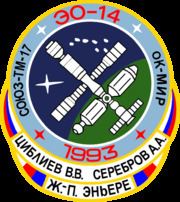COSPAR ID 1993-043A Apogee 397,000 m Dates 1 Jul 1993 – 14 Jan 1994 | Orbits completed ~3,070 Manufacturer NPO Energia Landing date 14 January 1994 Launch date 1 July 1993 | |
 | ||
Mission duration 196 days, 17 hours, 45 minutes, 22 seconds Launch mass 7,150 kilograms (15,760 lb) Operator Roscosmos State Corporation Members | ||
Soyuz TM-17 was a Russian mission to the space station Mir, launched on July 1, 1993. It lasted 196 days and 17 hours, making more than 3,000 orbits of the planet Earth. The Soyuz-TM crew transports (T - транспортный - Transportnyi - meaning transport, M - модифицированный - Modifitsirovannyi - meaning modified) were fourth generation (1986–2002) Soyuz spacecraft used for ferry flights to the Mir and ISS space stations. It added to the Soyuz-T new docking and rendezvous, radio communications, emergency and integrated parachute/landing engine systems. The new Kurs rendezvous and docking system permitted the Soyuz-TM to maneuver independently of the station, without the station making "mirror image" maneuvers to match unwanted translations introduced by earlier models' aft-mounted attitude control.
Mission highlights
Soyuz TM-17 was the 17th expedition to the Russian Space Station Mir.
At 7:37:11 a.m. Moscow time (MT), on 1994 January 14, Soyuz-TM 17 separated from the forward port of the Mir station. At 7:43:59 a.m., the Mission Control Center in Korolev (TsUP) ordered Tsibliyev to steer Soyuz-TM 17 to within 15 metres of the Kristall module to begin photography of the APAS-89 docking system. At 7:46:20 a.m., Tsibliyev complained that Soyuz-TM 17 was handling sluggishly. Serebrov, standing by for photography in the orbital module, then asked Tsibliyev to move the spacecraft out of the station plane because it was coming close to one of the solar arrays. In Mir, Viktor Afanasyev ordered Valeri Polyakov and Yuri Usachyov to evacuate to the Soyuz TM-18 spacecraft. At 7:47:30 a.m., controllers in the TsUP saw the image from Soyuz-TM 17’s external camera shake violently, and Serebrov reported that Soyuz-TM 17 had hit Mir. The TsUP then lost communications with Mir and Soyuz-TM 17. Intermittent communications were restored with Soyuz-TM 17 at 7:52 a.m. Voice communications with Mir were not restored until 8:02 a.m. Inspection of Soyuz-TM 17 indicated no serious damage. In this connection, the Russians revealed that they had studied contingency reentries by depressurized spacecraft in the wake of the Soyuz 11 accident. The Mir cosmonauts did not feel the impact, though the station’s guidance system registered angular velocity and switched to free flying mode.
Later analysis indicated that the right side of the orbital module had struck Mir two glancing blows 2 seconds apart. The impact point was on Kristall, near its connection to the Mir base block. The cause of the impact was traced to a switch error: the hand controller in the orbital module which governed braking and acceleration was switched on, disabling the equivalent hand controller (the left motion control lever) in the descent module. Tsibliyev was able to use the right lever to steer the Soyuz past Mir’s solar arrays, antennas, and docking ports after it became clear impact was inevitable.
